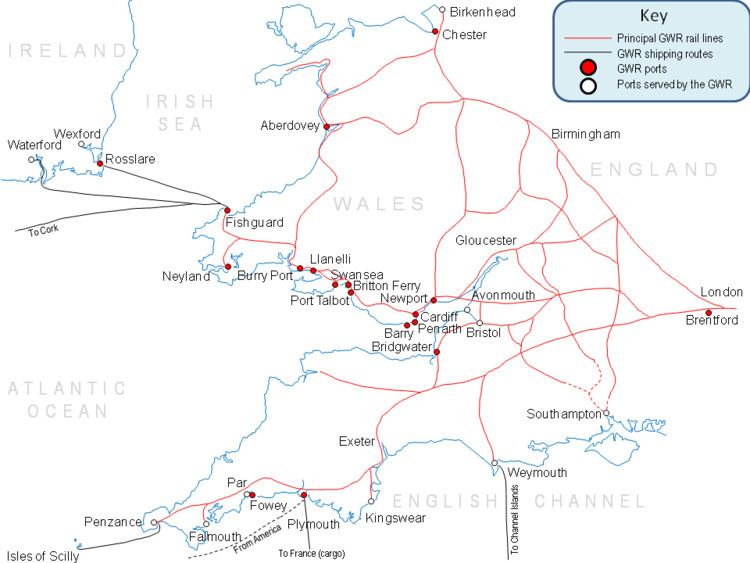Predecessor Ford and Jackson Founded 1871 | Successor British Railways Defunct 1948 | |
 | ||
The Great Western Railway’s ships operated in connection with the company's trains to provide services to Ireland, the Channel Islands and France. Powers were granted by Act of Parliament for the Great Western Railway (GWR) to operate ships in 1871. The following year the company took over the ships operated by Ford and Jackson on the route between Wales and Ireland. Services were operated between Weymouth, the Channel Islands and France on the former Weymouth and Channel Islands Steam Packet Company routes. Smaller GWR vessels were also used as tenders at Plymouth and on ferry routes on the River Severn and River Dart. The railway also operated tugs and other craft at their docks in Wales and South West England.
Contents
History
Isambard Kingdom Brunel, the GWR’s chief engineer, envisaged the railway linking London with the United States of America. He was responsible for designing three large ships, the SS Great Western (1837), SS Great Britain (1843; now preserved at Bristol), and SS Great Eastern (1858). The plans for the transatlantic routes from Bristol failed to materialise but the ships found other uses. Although they were never owned by the Great Western Railway Company, several shareholders and officers of the railway also had interests in the ships.
The company’s first vessels were two tugs working on the River Dee that were acquired with the Shrewsbury and Chester Railway in 1854. Two years later a service between Neyland in Wales and Waterford in Ireland was established in connection with the railway. This was operated by Ford and Jackson until 1 February 1872 when they were transferred to the railway company under powers obtained by the Great Western Railway (Steam Vessels) Act of 13 July 1871. The Act also allowed operation to the Channel Islands and France. These services were eventually provided from Weymouth, although the French services were only operated on a regular basis from 1878 to 1885. After this only cargo services were provided, often on a seasonal basis. The Channel Islands services were operated for the GWR by the Weymouth and Channel Island Steam Packet Company until August 1889 when the railway took on the operation of the route.
Meanwhile, the New Passage Ferry of the River Severn had become a GWR service when the Bristol and South Wales Union Railway was amalgamated in 1868. Another operation taken over by the GWR was the Plymouth Great Western Docks in 1876. The South Devon Railway Company held the majority of shares in the docks and was itself amalgamated with the GWR early in 1876. The docks used a fleet of tenders to land passengers and mails from [transatlantic liners moored off-shore; the lighters also operated excursions to coastal towns in Devon and Cornwall. Some cargo services were later operated form Plymouth to Nantes in France. Also in Devon, in 1901 the GWR took over the Dartmouth Passenger Ferry that linked Kingswear railway station with Dartmouth. The GWR also acquired a large shareholding in the West Cornwall Railway which itself owned a part of the West Cornwall Steam Ship Company; GWR ships were occasionally used on its route from Penzance.
On 30 August 1906 the GWR’s Welsh terminal was moved to a new harbour at Fishguard. It was hoped that transatlantic liners would also call en route to Liverpool but few did, Liverpool being forsaken for Southampton within a few years but this increased the number of liner calls at Plymouth. A similar change saw Rosslare become the principal railway harbour on the other side of Irish Sea although some services were still provided to Waterford. This work was undertaken in a joint venture with the Great Southern and Western Railway of Ireland known as the Fishguard and Rosslare Railways and Harbours.
Although it had a reputation as the "Great Way Round", the GWR opened several new lines to shorten its traditional main lines to the ports. The Severn Tunnel opened in 1886 to avoid a lengthy detour via Gloucester, although this saw the end of the company’s ferry service across the River Severn. Further improvements to the route between London Paddington station and Neyland came in 1903 when the South Wales and Bristol Direct Railway bypassed the congestion around Bristol Temple Meads, and again in 1913 when the Swansea District Lines allowed trains to avoid Swansea. In the meantime, trains to Weymouth had been speeded up following the opening of the Stert and Westbury Railway in 1900, and the special trains carrying passengers and mails off the transatlantic liners at Plymouth used this and the Langport and Castle Cary Railway which opened in 1906.
The Railways Act 1921 brought a number of additional railway companies into the GWR, several of which operated docks and several had small vessels operating in these. The companies concerned were the Barry Railway, Cardiff Railway, Taff Vale Railway, Alexandra (Newport and South Wales) Docks and Railway, Port Talbot Railway and Docks and the Swansea Harbour Trust. The GWR was nationalised on 1 January 1948 to become part of British Railways but the shipping services continued much the same as before for several years.
River ferries
A to M
N to Z
Liveries
Hulls were painted black with red below the waterline; from 1889–1914 there was a white band at main deck level. Paddle-boxes and upper works were buff coloured, funnel red, and the company’s coat of arms was carried on the bow. Fishguard and Rosslare vessels were similar but had brown, later white, upper works. The flag was white with narrow red bands at top and bottom.
